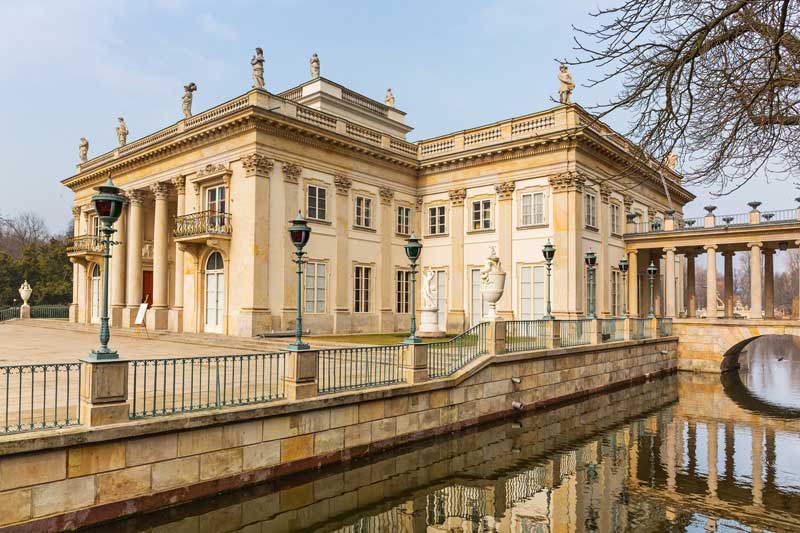
With an exciting history of more than 700 years old, Warsaw, the Capital City of Poland, has dozens of historical palaces. The Palace on the Isle, also known as the Baths Palace, is one of the city’s finest examples of classicist-style architecture, located in the vast and beautiful Łazienki Park, situated in the heart of the city.
Set on an artificial island in the middle of a large lake, with its classic colonnades gracefully connecting the palace to the lakeshore on either side, the palace was originally a Baroque Bath House, called Łazienka. Commissioned in about 1680 by Stanisław Lubomirski, a Polish nobleman and politician, the Bath House was erected on a square plan, according to the design of Tylman van Gameren, the most outstanding architect in the country at that time, richly decorated with stuccos, statues, and paintings. Nearly after a century, Stanisław August Poniatowski, the last King of Poland, purchased the entire estate in 1766, intending to covert the Bath House into his summer palace, adorned with an English garden. Instructed by the king, the Bath House was remodeled by Domenico Merlini between 1764 and 1795, converting it into the Palace on the Isle, while the green area around the palace was turned into the amazing Lazienki Park.

The square-shaped structure of the Bath House, decorated with a fountain, contained a round hall, the walls of which were studded with pebbles, seashells and imitated grotto, topped by a cupola and illuminated from above by lanterns. The circular hall was joined to a bath chamber with walls adorned by bas-reliefs. Both sides of the buildings were richly decorated with stucco, sculptures and murals.
Even after the renovation and remodelling, some of the original decorations survived on the entrance wall of the columned portico, along with the Latin inscription, declaring that the house loathes sorrow and grief, loves peace, offers a bath and recommends an idyllic life, wishing to play host to honest men. Apart from that, the decorations of the main entrance hall, the Chamber of Bacchus and the Bath-Chamber have also survived.

The Old Bath House, which was turned into the Palace on the Isle by King Stanisław August Poniatowski, is an outstanding example of the classicist style in Poland. The artificial island, on which the palace is located, divides the lake into two parts, a smaller northern lake and a larger southern one, while the palace is connected to the encompassing park by two ionic colonnaded bridges. The axis of the palace was set off by two monumental marble fireplaces in the form of wall porticoes, featuring statues of Apollo and Heracles set against the shorter walls.
The longer white marbled walls were decorated with vertical panels, painted by Jan Bogumił Plersh, the reputed Polish sculptor of German origin, in the style of Raphael's grotesques in the Vatican.

The Bacchus Room, located on the ground floor of the palace, is decorated with 17th-century Dutch blue tiles and houses the paintings of the Flemish painter Jacob Jordaens, depicting Silenus and his foster son, Bacchus, the god of wine. However, the room owes its name to the 1778 ceiling painting, also created by Jan Bogumił Plersh, representing Bacchus, Ceres, Venus and Cupid, which was, unfortunately, burned by German forces in 1944, during WW II. The Rotunda, designed by Domenico Merlini and located in the central part of the palace, is one of the most important examples of neoclassical decoration within the palace. Adorned in yellow and white marble, with figures of the Polish Kings, it leads to the Bath Room and the Ballroom. The lower Painting Gallery, located on the other side of the Rotunda, contains invaluable works of famous painters like Rubens and Rembrandt, along with a chapel. Apart from that, the ground floor of the Palace on the Isle also contains the famous Dining Room, embellished with classical furniture and paintings, in which the famous Thursday Dinners were arranged to which the scholars, writers and poets were invited by King Stanisław August Poniatowski.

However, the Solomon Room, embellished with a series of paintings depicting the History of Solomon, is one of the largest rooms on the ground floor of the palace. The series, comprising six paintings, namely The Dream of Solomon, The Queen of Sheba before Solomon, The Judgment of Solomon, Consultation with King Hiram, Dedication of the Temple and Solomon's Sacrifice, were executed between 1791 and 1793 by Marcello Bacciarelli, who depicted King Stanislaw Augustus as the biblical king. Unfortunately, all those paintings were foolishly burned by the Nazis in 1944, during the Great War.
The Royal Apartments and the Royal Bed Chambers, along with the Balcony Room, the King's Cabinet, the Cloakroom, the Officer’s Room and the Upper Painting Gallery, are located on the first floor of the Palace on the Isle.

The Nazi occupation of Poland during WW II was a tragic period for Łazienki, when all the historic buildings of Warsaw, along with the Palace on the Isle, were taken over by the German military. As if that was not all, before evacuating the palace towards the end of December 1944, the Nazis drilled some one thousand holes in its walls to place the dynamites, drenched them with petrol and set the complex on fire, intending to blow it up, like the Royal Castle. Fortunately, they failed to succeed. Following the end of the war, a vigorous and strenuous reconstruction project of the Łazienki royal complex was taken up, which continued for nearly two decades. Finally, the first seven chambers on the ground floor were opened to the public in 1960, while the entire first floor was opened in 1965.